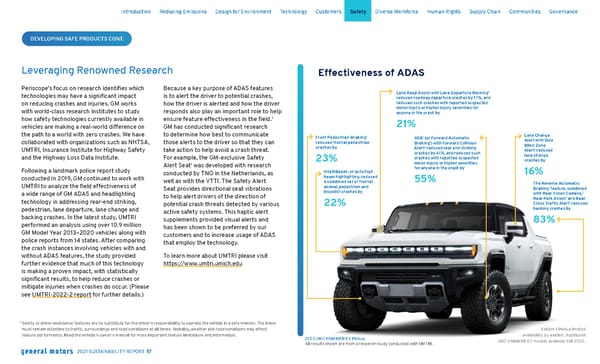DEVELOPING SAFE PRODUCTS CONT. Leveraging Renowned Research Periscope’s focus on research identifies which technologies may have a significant impact on reducing crashes and injuries. GM works with world-class research institutes to study how safety technologies currently available in vehicles are making a real-world difference on the path to a world with zero crashes. We have collaborated with organizations such as NHTSA, UMTRI, Insurance Institute for Highway Safety and the Highway Loss Data Institute. Following a landmark police report study conducted in 2019, GM continued to work with UMTRI to analyze the field effectiveness of a wide range of GM ADAS and headlighting technology in addressing rear-end striking, pedestrian, lane departure, lane change and backing crashes. In the latest study, UMTRI performed an analysis using over 10.9 million GM Model Year 2013–2020 vehicles along with police reports from 14 states. After comparing the crash instances involving vehicles with and without ADAS features, the study provided further evidence that much of this technology is making a proven impact, with statistically significant results, to help reduce crashes or mitigate injuries when crashes do occur. (Please see UMTRI-2022-2 report for further details.) Because a key purpose of ADAS features is to alert the driver to potential crashes, how the driver is alerted and how the driver responds also play an important role to help ensure feature effectiveness in the field. 1 GM has conducted significant research to determine how best to communicate those alerts to the driver so that they can take action to help avoid a crash threat. For example, the GM-exclusive Safety Alert Seat 1 was developed with research conducted by TNO in the Netherlands, as well as with the VTTI. The Safety Alert Seat provides directional seat vibrations to help alert drivers of the direction of potential crash threats detected by various active safety systems. This haptic alert supplements provided visual alerts and has been shown to be preferred by our customers and to increase usage of ADAS that employ the technology. To learn more about UMTRI please visit https://www.umtri.umich.edu Effectiveness of ADAS Front Pedestrian Braking 1 reduced frontal pedestrian crashes by 23% IntelliBeam 1 , or auto high beam highlighting, reduced a combined set of frontal animal, pedestrian and bicyclist crashes by 22% Lane Keep Assist with Lane Departure Warning 1 reduced roadway departure crashes by 17%, and reduced such crashes with reported suspected minor injury or higher injury severities for anyone in the crash by 21% AEB 1 (or Forward Automatic Braking 1 ) with Forward Collision Alert 1 reduced rear end striking crashes by 41%, and reduced such crashes with reported suspected minor injury or higher severities for anyone in the crash by 55% Lane Change Alert with Side Blind Zone Alert 1 reduced lane change crashes by 16% The Reverse Automatic Braking 1 feature, combined with Rear Vision Camera, 1 Rear Park Assist 1 and Rear Cross Traffic Alert 1 reduced backing crashes by 83% 1 S afety or driver assistance features are no substitute for the driver's responsibility to operate the vehicle in a safe manner. The driver must remain attentive to traffic, surroundings and road conditions at all times. Visibility, weather and road conditions may affect feature performance. Read the vehicle's owner's manual for more important feature limitations and information. Edition 1 Pickup limited availability by waitlist. Additional GMC HUMMER EV models available Fall 2022. All results shown are from a research study conducted with UMTRI . 2022 GMC HUMMER EV Pickup Skip Navigation Introduction Reducing Emissions Design for Environment Technology Customers Safety Diverse Workforce Human Rights Supply Chain Communities Governance 2021 SUSTAINABILITY REPORT 57
 General Motors Sustainability Report Page 57 Page 59
General Motors Sustainability Report Page 57 Page 59